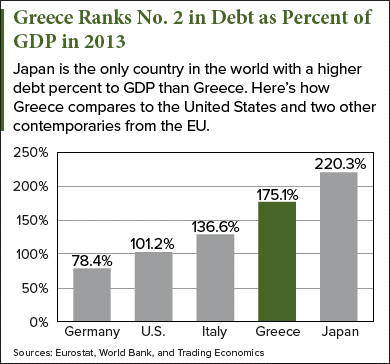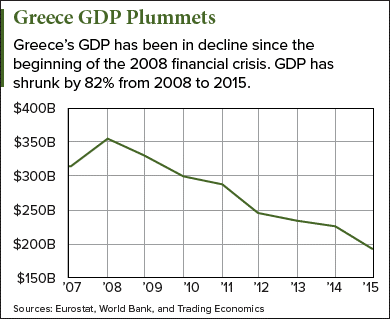The Greek debt-to-GDP ratio is a whopping 179% as of December 2016, and the total amount Greece owes is €293 billion ($327.5 billion).
While the three bailouts the country has received since 2010 allowed it to keep paying its bills, they continued to increase its debt. They also didn't help grow the economy. In fact, GDP has slipped 45% since 2008.
Because the duel problems of increasing debt and decreasing GDP are not being solved, the debt-to-GDP ratio is only going to continue to increase in 2017.
 In 2013, Greece had the second-highest debt-to-GDP ratio in the world at 175.1%. The bailout funds that the country is trying to secure before July will add another €7.6 billion ($8.5 billion) to its debt load.
In 2013, Greece had the second-highest debt-to-GDP ratio in the world at 175.1%. The bailout funds that the country is trying to secure before July will add another €7.6 billion ($8.5 billion) to its debt load.
While the country's debt in dollars has remained roughly the same at $179 billion, the debt-to-GDP ratio has continued to climb.
In 2013, the debt-to-GDP ratio was 175.1%. At the end of 2016, the ratio was 179%, a 4% gain despite the debt only growing 1%.
The main culprit of the growing debt-to-GDP problem is not being addressed. And that problem is a declining GDP...
Greece's Vicious Rising Austerity, Decreasing GDP Cycle
Like most Western countries, Greece was hard hit by the 2007-2008 recession. To make matters worse, Greece had been underreporting its deficit for many years. When the recession shrank its economy, Greece's budget deficit rose to 12.5% GDP.
Must See: This Great Depression-Era "Secret" Helped Transform Two Teachers into Millionaires. Read more...
The huge budget deficit poses an even bigger problem for Greece. The Eurozone has a stability and growth agreement that sets a 3% limit for this figure. When Greece released the actual size of the country's debt, its credit rating was lowered. As a result, borrowing on the open market to pay its financial obligations wasn't an option.
 In 2010, the EU and the International Monetary Fund (IMF) agreed to the first bailout for Greece. In exchange for the €20 billion ($22.4 billion), Greece enacted an austerity plan that included freezing wages, reducing pensions, and raising taxes.
In 2010, the EU and the International Monetary Fund (IMF) agreed to the first bailout for Greece. In exchange for the €20 billion ($22.4 billion), Greece enacted an austerity plan that included freezing wages, reducing pensions, and raising taxes.
Since then, Greece has been bailed out two more times. The effects of these bailouts have been twofold. First, the bailouts have caused the debt to grow. In 2008, the country had €240 billion ($269 billion) in debt. By 2012, Greece's debt had grown 54% to €370 billion ($414.8 billion).
But ballooning debt wasn't the only problem. Greece's GDP continued to decline from 2008 through 2016 due to the austerity measures. Greek GDP was $194 billion last year. That is 45% lower than the 2008 GDP of $354.5 billion.
The austerity plans raised taxes to pay the debt, but it shrank the economy in the process. Wage freezes cut into consumer spending, while higher taxes inhibited business growth.
The rising debt burden and declining GDP are a recipe for a skyrocketing Greek debt-to-GDP ratio. Until GDP can grow and borrowing can be slowed, the problem will not be corrected.
Up Next: Greece has been on shaky financial ground for almost a decade. Here's everything you need to know about the crisis to profit...
Follow Money Morning on Twitter @moneymorning, Facebook, and LinkedIn.
[mmpazkzone name="end-story-hostage" network="9794" site="307044" id="138536" type="4"]


